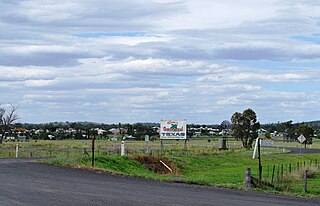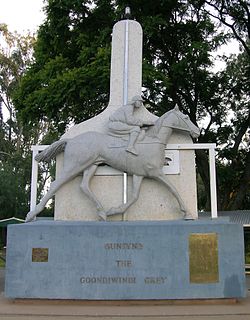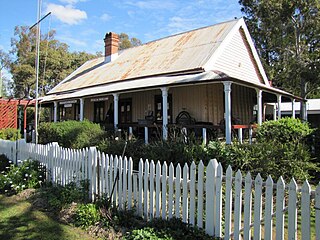
Texas is a town and locality in the Goondiwindi Region, Queensland, Australia. In the 2016 census, Texas had a population of 843 people, down from 1,159 people just five years earlier.

Inglewood is a rural town and locality in the Goondiwindi Region, Queensland, Australia. In the 2016 census, Inglewood had a population of 954 people. Inglewood is the second largest town in the Goondiwindi Region.

Goondiwindi is a town and a locality in the Goondiwindi Region, Queensland, Australia. At the 2016 census, the town had an urban population of approximately 5,500.

Yelarbon is a town and a locality in the Goondiwindi Region, Queensland, Australia. In the 2016 census, Yelarbon had a population of 364 people.
The Bigambul people are an indigenous people of Australia of the Northern Tablelands and Border Rivers regions of New South Wales and Queensland.

Frederick Walker public servant, property manager, Commandant of the Native Police, squatter and Australian explorer.

Australian native police units, consisting of Aboriginal troopers under the command usually of a single white officer, existed in various forms in all Australian mainland colonies during the nineteenth and, in some cases, into the twentieth centuries. The Native Police were utilised as a cost effective and brutal paramilitary instrument in the expansion and protection of the British colonial frontier in Australia. Mounted Aboriginal troopers of the Native Police, armed with rifles, carbines and swords escorted surveying groups, pastoralists and prospectors into frontier areas. They would usually then establish base camps and patrol these areas to enforce warrants, conduct punitive missions against resisting local Aboriginal groups, and fulfil various other duties. To maintain the imperial British method of "divide and conquer" and to reduce desertions, the Aboriginals within the Native Police were routinely recruited from areas that were very distant from the frontier places in which they were deployed. As the troopers were Aboriginal, this benefited the colonists by minimising both the wages of the police and the potential for Aboriginal revenge attacks against white people. It also increased the efficiency of the force as the Aboriginal troopers were vastly superior in their ability to track down dissidents in often poorly charted and difficult terrain.

Moonie is a rural town in the Western Downs Region and a locality split between the Western Downs Region and the Goondiwindi Region in Queensland, Australia.

Toobeah is a town and a locality in the Goondiwindi Region, Queensland, Australia. At the 2011 census, Toobeah and the surrounding rural area had a population of 218.

Customs House Museum is a heritage-listed former detached house and now museum at 1 McLean Street, Goondiwindi, Goondiwindi Region, Queensland, Australia. It was built from 1860s circa to 1900s circa. It was added to the Queensland Heritage Register on 21 October 1992.

Bonshaw is a locality in the Goondiwindi Region, Queensland, Australia.

Goodar is a locality in the Goondiwindi Region, Queensland, Australia.

Gore is a town and a locality in the Goondiwindi Region, Queensland, Australia. In the 2016 census, Gore had a population of 36 people.

Maidenhead is a locality in the Goondiwindi Region, Queensland, Australia.

Mosquito Creek is a locality in the Goondiwindi Region, Queensland, Australia.

Terrica is a locality in the Goondiwindi Region, Queensland, Australia.

Wyaga is a locality in the Goondiwindi Region, Queensland, Australia.

Yagaburne is a locality in the Goondiwindi Region, Queensland, Australia.
Richard Purvis Marshall was a British pastoral squatter and high ranking Native Police officer in the colonies of New South Wales and Queensland. He was co-founder of the Gundi Windi cattle and sheep run which later evolved into the town of Goondiwindi. He was appointed to the Native Police in 1850 and became Commandant of the force in 1855. He retired from the Native Police in 1856 and held various Justice of the Peace and police magistrate roles in Goondiwindi until his death in 1872.

Edric Norfolk Vaux Morisset was a high ranking officer in both the paramilitary and civilian police forces of the New South Wales and Queensland colonies of the British Empire. He was Commandant of the paramilitary Native Police from 1857 to 1861 and concurrently became the first Inspector General of Police in Queensland in 1860. Morisset afterwards was appointed Superintendent of Police at Bathurst and then later on at Maitland. From 1883 until his death in 1887, Morisset was Superintendent of the Southern Districts and Deputy Inspector General of Police in New South Wales.










